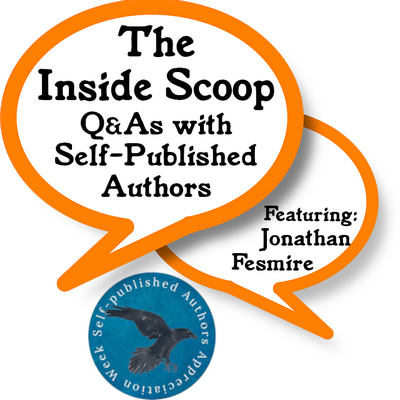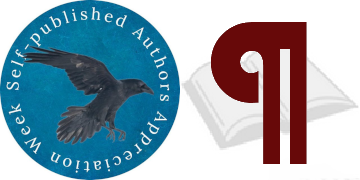
I’ve talked about Fesmire’s Steampunk Westerns a lot–I’ve even promoted his crowd-funding campaigns. So I was quite pleased to get him to talk about his self-publishing work, too. I hope you enjoy it.
Before we get into things, why don’t you give the reader a brief introduction to you and your work.
Sure! I’ve been writing for decades, and I’ve been a science fiction, fantasy, and horror fan all my life. I write steampunk westerns with robots and zombies, all in the same world I’ve been building for years. I call it the Creedverse, after the main character, 1870s lawman James “Bodacious” Creed.
The easiest way to find all my links is via my Linktree site at https://linktr.ee/jonathanfesmire. From there, you can visit my website, join my newsletter and get a free short story, check out my books on various sites, including Audible, visit the Creedverse site, and even check out my TikTok channel.
What kind of costs are associated with self-publishing a book? Do you hire one or more editors, or one editor for a couple of passes? Cover artist? Anyone to help with layout, design, etc.? Beta readers? Or do you take it all on yourself? Are you actually making any money at this, or are you still focused on breaking-even while building an audience?
Yep, there are definitely costs involved. I often have one or two beta readers who do that for free because they like my work. I also have an editor whom I pay. If I feel that the book doesn’t need any more story suggestions, I’ll pay for a line edit, but if I think it could use a critique, I’ll pay for that, too. I work with KH Koehler, who does a fantastic job. I also pay for cover art, though I have an art degree and I think I’ve now learned enough to create my own, professional covers going forward. As for layout, I do that myself. I actually use the Kindle Direct Publishing templates, which work great.
Are you using any kind of crowd-funding to help with that? What have those experiences been like?
Indeed I do! I’ve run crowdfunding campaigns for my trilogy, The Adventures of Bodacious Creed. It’s a fantastic way to get the word out about the new book, make some early sales, and get enough money to pay for editing and cover art, plus fulfilling the rewards.
For the first book in my series, Bodacious Creed: a Steampunk Zombie Western, I ran the Kickstarter when I had a basic outline for the novel. I knew I’d be able to write it. What this allowed me to do is give backers, depending on their backer level, input into the story. One integral character was based on the backer himself. By the time I was on the third book, Bodacious Creed and the San Francisco Syndicate, I’d written the first draft, then ran the campaign.
As I recall, you’ve used a couple of different crowd-funding sites in the past. What are the pluses/minuses for each? Any advice for someone thinking of trying this method?
I prefer Kickstarter, because Kickstarter has a larger audience than Indiegogo. With Kickstarter, if your project doesn’t raise it’s goal, it doesn’t go through. But on Indiegogo, you can have a goal, and get the funding even if the project makes less. So, here’s what I figured out with my last Kickstarter campaign, the one for my novel Bodacious Creed and the San Francisco Syndicate: Set the goal to the lowest amount that will help you.
Here’s what I mean by that. You may have a project that you need a certain amount of money to even be able to afford. Maybe you project that it will cost $2,000 just to develop a product. Then, you need to fulfil the backer orders, including shipping. Certain backer levels will cost a higher percentage of what backers pay for you to produce. For example, digital copies of books are essentially free to send out, while print copies cost more. So, if someone pledges $5.00 for a digital book, that’s $5 you can put toward costs like editing and cover art. If a person pledges $25 for a paperback (plus $5 for shipping), you may make $15 on that. That’s 100% toward development for the digital copies, and 60% from the print copy (not counting the shipping).
I recommend people check out Don Stainsberg’s The Kickstarter Handbook, which provides the info they’ll need to create a spreadsheet to figure out how low they can set their goal and still make enough to cover everything.
Anyway, what I realized when running my last Kickstarter was this. I was going to pay for editing and cover art, anyway. And that meant that any bit of money I raised from a Kickstarter would offset my costs, and I could set the goal to something low. I set it for $300. If that meant I ended up with $150 to put toward those services, that was better than nothing. What ended up happening, though, was the $300 was pledged in six hours! I added a sticker to the graphic that said, “Funded in 6 hours!” That looks really good to potential backers. And it ended up raising $1,681. I was hoping for $1,600, so that was great.
So, my advice would be to use Kickstarter, but put the goal at the lowest level that will cover your expenses. Or, if you plan to pay those, anyway, you can set it even lower.
How do you juggle marketing/PR/etc. with writing new work? (along with day jobs, family, hobbies, etc., etc.)
I’m lucky that I work from home! At my day job, I’m a content writer, so I’m basically writing for work, writing my fiction, worldbuilding, or editing a lot of the time. I’m a single dad and, of course, spend a lot of time with my son. But being able to do all my work from home really helps.
Self-publishing tends to have less external deadlines keeping one accountable. How do you maintain your work process or work ethic?
You have to get to a point where you internalize the urgency to write. Also, you need to remember that it’s a long-haul sort of profession. Writing a novel takes time. Get 500 to 1,000 words written a day, and you’re making good progress. If you can do more, great. But you need to understand it’s a process you need to take a day at a time.
“Internalize the urgency,” I like that phrase. It lines up with what some others in this series are telling me—it’s not so much a matter of work-ethic (although I’m sure it’s there, too), but about interest in the work. Did you have to cultivate that to go from “aspiring author” to “working author” or did you start with it?
’ve definitely had periods when I wasn’t writing much, and in the aughts, I focused on digital art for a while. I’m glad I got back to writing, which I feel is my true calling.
Writers are people who feel a need to write and do so to get their thoughts down. It’s how we best deal with our emotions and everything going on in our heads. So, writing is just what I do. And I write a lot every day. Most days, I write in my online journal, I work on whatever book I have in progress, and I also write for my day job as a content writer.
I think I had to accept that this is just what I do, and that it’s good for me. The fact that I’m not getting any younger helps, too! I’m 53, and by the time I leave this world, I want to have a lot of books out. I also hope to make enough off my books so that when I retire from my day job, I’ll be making a good living on top of my social security.
One thing that helped a lot is learning to outline my books before writing them. I have to admit, it took me a long time to learn that. I was a pantser for too long, and that meant my books came along painfully slowly. Now, rather than taking four years to write a book, it takes me a year to a year and a half. And I’m trying to streamline that even more. (A pantser is someone who writes books without a plan and figures it out as they go.) I now use a beat sheet to plan the major plot points of a novel and figure out how to get from one point to the next as I go.
Another useful way to get a lot of writing done is by using the pomodoro technique, also known as writing sprints. Set an alarm for 15 to 25 minutes, and during that time, all you do is write. When the timer goes off, you stop, and take a short break, then repeat. Do this a few times every day, and you’ll get a lot of writing done.
Thanks for your time and participation! Hope you enjoyed it! And do know that there are many of us out here who appreciate and applaud what you do (and our number is growing)!
If you like Steampunk, Westerns, Zombies–especially all three–or just books that are fun and well-told, be sure to check out all of Fesmire’s work!

Clker-Free-Vector-Images from Pixabay
The 2023 Self-Published Authors Appreciation Week Logo was made by Witty and Sarcastic Book Club



1 Pingback